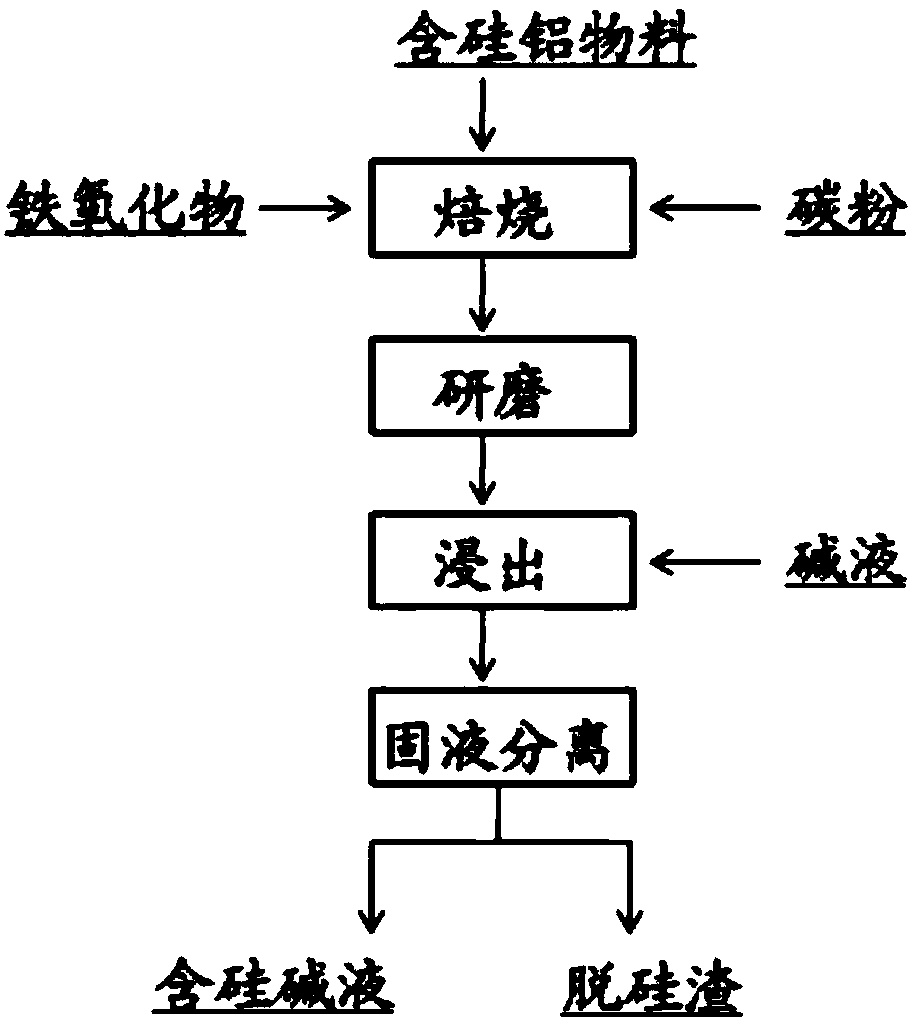Silicon removal method of silicon-aluminum-containing material
A material, silicon-aluminum technology, applied in the field of desiliconization of silicon-aluminum-containing materials, can solve the problems of difficult desiliconization of high-silicon and aluminum-containing minerals, low silicon oxide dissolution rate, etc., and achieves low cost, good economic benefits, and removal rate. high effect
- Summary
- Abstract
- Description
- Claims
- Application Information
AI Technical Summary
Problems solved by technology
Method used
Image
Examples
Embodiment 1
[0033] According to the molar ratio of iron oxide: alumina in kaolin: carbon = 2.4:4:1.2 for batching and pelletizing. The dried pellets are placed in a corundum crucible, roasted in a reducing atmosphere, and the atmosphere is adjusted with coke. The roasting temperature is 1100°C, and the roasting time is 60 minutes; the obtained roasted clinker is finely ground to about d(0.5)=43.52 μm, and the roasted clinker is desiliconized by alkali leaching with sodium hydroxide alkali solution, the leaching temperature is 125°C, liquid-solid The ratio is 5, the caustic alkali concentration is 125g / L, and the leaching time is 120min. Under these conditions, the dissolution rate of silicon oxide is 91.13%, and the aluminum-silicon ratio of the leaching slag is 9.11.
Embodiment 2
[0035] According to the molar ratio of iron oxide: alumina in kaolin: carbon = 2.4:4:1.2 for batching and pelletizing. The dried pellets are placed in a corundum crucible, roasted in a reducing atmosphere, and the atmosphere is adjusted with coke. The roasting temperature is 1100°C, and the roasting time is 60 minutes; the obtained roasted clinker is finely ground to about d(0.5)=43.52 μm, and the roasted clinker is desiliconized by alkali leaching with sodium hydroxide alkali solution, the leaching temperature is 110°C, liquid-solid The ratio is 3, the caustic alkali concentration is 125g / L, and the leaching time is 120min. Under these conditions, the dissolution rate of silicon oxide is 87.04%, and the aluminum-silicon ratio of the leaching slag is 6.25.
Embodiment 3
[0037] According to the molar ratio of iron oxide: aluminum oxide: carbon = 2.4:4:1.2 in the high-silicon-containing silicon-aluminum material is used for batching and pelletizing. The dried pellets are placed in a corundum crucible, roasted in a reducing atmosphere, and the atmosphere is adjusted with coke. The roasting temperature is 1100°C, and the roasting time is 60 minutes; the obtained roasted clinker is finely ground to about d(0.5)=28.52 μm, and the roasted clinker is desiliconized by alkali leaching with sodium hydroxide alkali solution, the leaching temperature is 110°C, liquid-solid The ratio is 10, the caustic alkali concentration is 125g / L, and the leaching time is 120min. Under these conditions, the dissolution rate of silicon oxide is 77%, and the aluminum-silicon ratio of the leaching slag is 8.57.
PUM
 Login to View More
Login to View More Abstract
Description
Claims
Application Information
 Login to View More
Login to View More - R&D
- Intellectual Property
- Life Sciences
- Materials
- Tech Scout
- Unparalleled Data Quality
- Higher Quality Content
- 60% Fewer Hallucinations
Browse by: Latest US Patents, China's latest patents, Technical Efficacy Thesaurus, Application Domain, Technology Topic, Popular Technical Reports.
© 2025 PatSnap. All rights reserved.Legal|Privacy policy|Modern Slavery Act Transparency Statement|Sitemap|About US| Contact US: help@patsnap.com



